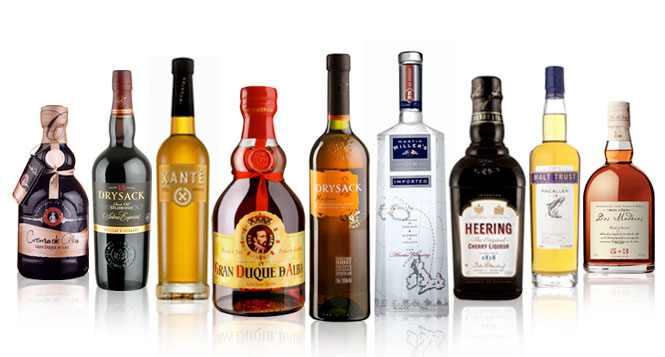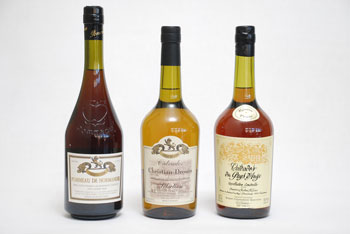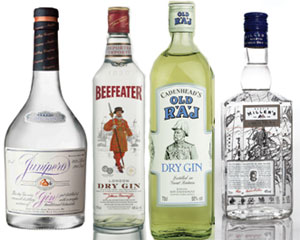
Elite life
Elite Alcoholic Drinks
Page 1
World Cuisine Recipes
Elite Alcoholic Drinks
Cocktails
Alcoholic Cocktails
Non-Alcoholic Cocktails
Nastoykas (Tinctures)
Nalivkas (Fruit Liqueurs)
Liquors
Jams
Compotes
Juices
Mushrooms
Mushroom Recipes

Absinthe
It was traditionally served with ice water and a cube of sugar; the sugar cube was placed on a slotted "absinthe spoon", and the water was drizzled over the sugar into the glass of absinthe (typically in a 3:1 or 4:1 ratio). The sugar helped take the bitter edge from the absinthe, and when the water is drizzled into the the liquor it all turns milky greenish-white (the effect is called "louche"). The drink was referred to in France as "La Fée Verte", or The Green Fairy, which is a reference to its often dazzling green color (depending on the brand).
A French expatriate living in Switzerland by the name of Dr. Ordinaire found the answer by inventing absinthe, which delivered both the herb and alcohol in a stunningly tart beverage, with a flavor resembling licorice. The most well-known maker of absinthe was French distiller Henri-Louis Pernod, who was impressed with Dr. Ordinaire's beverages and purchased the secrets of its distillation and manufacture.
Around the turn of the century, after observing a subset of alcoholism referred to as "absinthism", and noting that heavy absinthe users had a propensity toward madness and suicide, by the second decade of this century it became banned in the Western world, unfairly lumped in with opiates, cocaine, and marijuana when it is, in fact, just another alcoholic beverage (although one with unique properties). Although the effects of thujone can be toxic when consumed in very large quantities, this substance is found in properly made and distilled absinthe in only the smallest trace amounts.
Brands of Absinthe, producible in Czech Republic
Brands of Absinthe, producible in France
Brands of Absinthe, producible in Italy
Brands of Absinthe, producible in Russia
Brands of Absinthe, producible in Spain
Brands of Absinthe, producible in Switzerland


Armagnac
Although it undergoes the same long ageing in oak barrels, Armagnac is mainly distilled once and at a lower % of alcohol than Cognac, which results in more intense fruit character and rustic flavours. Armagnac is mainly aged in local oak casks which impart subtle colour and complex flavour which is distinctively different from the more pronounced sweet vanillin character of the cognac caks. In terms of ageing, an "XXX" or "VS" armagnac blends several armagnacs matured at least two years in wood. For the VSOP, the minimum is at least five years, and for XO, at least six. Older and more complex armagnacs from a single year are dated "vintages".
There are 10 authorised grape varieties for the production of Armagnac, although Ugni Blanc, Baco 22A , Folle Blanche and Colombard dominate the blend. There remains a mood of experimentation in Armagnac: they freely use more fragrant grape varieties, along with a variety of distillation methods. It is slightly more rustic in style than Cognac, softer and rounder, with a fuller flavour on both nose and palate. Berrys lists an impressive library of vintage Armagnacs from the family-owned house of Nismes-Declou which traces its origins back to 1832. It produces Armagnacs of extraordinary intensity and finesse, allied with the capacity of ageing effortlessly for up to a century, and sometimes even longer.
Brands of Armagnac, producible in France

Brandy
Brands of Brandy, producible in Greece
Brands of Brandy, producible in France
Brands of Brandy, producible in Portugal
Brands of Brandy, producible in Spain

Calvados
When one thinks of Normandy one thinks of a land of orchards planted with apple trees. The apple symbolises the agricultural tradition of Normandy and is used within the flag of the general council of Calvados. Throughout history the apple has been a pillar in the economic and cultural welfare of Normandy. Cider and calvados have traditionally been produced on the farm in Normandy since the Middle-Ages. Many ancient cider presses with circular millstones made of granite can still be seen throughout the Normandy countryside. Normandy cider is very different to the cider produced in the United Kingdom and when that cider is distilled calvados is born. The first official written references to calvados distilling date back to the 16th century long before it took the name of calvados. While brandy can made anywhere in the world the apple brandy calvados can only be produced in this special region of France. Many factors help set it apart from other brandy and it all starts with the soil, climate and agricultural heritage, of the people of Normandy.
Calvados received “Appellation d’Origine” status in 1942 and today three different appellations exist for calvados and one for Pommeau. Each appellation has unique and distinguishing characteristics, which concern the geographical area and the distillation process. The geographical production areas are strictly defined and all operations that result in the production of calvados and Pommeau are carried out within these zones. The “Appellation Controlee System” is a set of rules designed to guarantee and maintain the characteristics and quality of the product and its century old traditions.
Good calvados should have a discreet aromatic reminiscence of apples. The taste test will leave the lips with a notable sharpness from the acidity of the cider. Combine this with a pleasing dryness and depth and you'll soon appreciate why this is such a superb digestif.
Brands of Calvados, producible in France

Cognac
Everything began at I age A.D. when on the modern territory of France the grapes was delivered by the Romans. The Saintonge vineyards appeared during the governing of the Roman emperor Probus that extended the privileges and rights on possession of vineyards and making cognacs for all Gauls. At first vine was cultivated on Rhone’s plain, and to IV A.D. it was spread through all France. In XII A.D. from the resolution of William X, Duke of Guyenne, the huge territory wine production, known as Vignoble de Poitou, was opened. Wines made in Vignoble de Poitou, were highly appreciated in the countries of Northern Sea. Transportation was made by Dutch ships, which bought salt in Poitou. In XVI A.D. France turned into the main producer and exporter of wines in Europe. The Dutch ships floated to Cognac area to buy well-known wines from areas Champagne and Borderies. The vineyards Aunis produced such huge quantity of wine that it became difficult to transport, because these low alcoholic wines were exhaled during long ocean carriages. Transportation of wine to warm countries turned to be not so profitable as the wine spoilt and became rotten after a long-distance carriage. So French wine-producers decided to apply the process of distillation that was used rarely at that time. They thought, that if the consumer poured water to distillate, he would receive wine again. However, wine-producers liked this cognac spirits or distillate, which they mixed with water and this drink was called brandjiwin or "burnt wine".
It is difficult to say, how cognac appeared. There is a legend, according to which Chevalier de la Croix leaved military service and started to distillate wine. He dreamed that the Devil came to take away his soul, and threw him into boiled water, but nothing happened, and threw him again. Woken up, Chevalier decided to apply the process of double boiling during cognac production. The second boiling should improve the wine quality after the first boiling. Then Chevalier took two casks with received drink and went to Renorville monks. The content of the first was drunk out at once, and the second barrel was locked in a cellar for celebration any other event. This event took place only fifteen years later, when the monks visited Chevalier. To their surprise the barrel wasn’t full, the evaporation had made its affair, the drink gained new taste, more bright and mature. So that was the birth of cognac. To XVII A.D. the market became steadier, first cognac houses were created, some of which still exist. They collected cognac and linked with the buyers from Holland, England and Northern Europe, later extending to America and Far East. More and more cognac trade houses were opened, and in the middle of XIX A.D. they began to carry cognac in bottles, instead of casks. This new trade gave rise to such industries as glassmaking, production of corks and packaging, printing. By that time vineyards took almost 280 thousand hectares. In 1875 the Phylloxera virus appeared in Charente, and destroyed vineyards up to 40 thousand hectares by 1893.
During the first quarter of XX A.D. the vineyards were reduced, using American investments, however they have not achieved the previous output level. The careful attitude improved considerably the harvest; the decrees were published, which regulated each stage of cognac production. These decrees control the process of cognac production, which now becomes a very valuable and popular drink.
Brands of Cognac, producible in Armenia
Brands of Cognac, producible in France
Brands of Cognac, producible in Georgia
Brands of Cognac, producible in Moldova
Brands of Cognac, producible in Russia

Gin
The first confirmed date for the production of gin is the early 17th century in Holland, although claims have been made that it was produced prior to this in Italy. In Holland it was produced as a medicine and sold in chemist shops to treat stomach complains, gout and gallstones. To make it more palatable, the Dutch started to flavour it with juniper, which has medicinal properties of its own. British troops fighting in the Low Countries during the Thirty Years' War were given 'Dutch Courage' during the long campaigns in the damp weather through the warming properties of gin. Eventually they started brining it back home with them, where already it was often sold in chemists' shops. Distillation was taking place in a small way in England, but it began on a greater scale, though the quality was often very dubious. The new drink became a firm favourite with the poor. Members of the formation by King Charles I of the Worshipful Company of Distillers hold the right to distill spirits in London and Westminster. It improved both the quality of gin and its image, it also helped English agriculture by using surplus corn and barley.
When King William III, better known as William of Orange came to the English throne in 1689, he made a series of statues actively encouraging the distillation of English spirits. Anyone could now distill by simply posting a notice in public and just waiting 10 days. Sometimes gin was distributed to workers as part of their wages and soon the volume sold daily exceeded that of beer and ale, which was more expensive. In 1729 an excise license of Ј20 was introduced and two shillings per gallon duty was levied. Retailers also required a license. This almost suppressed good gin, but the quantity consumed of bad spirits continued to rise. In 1730 London had over 7,000 shops that sold only spirits. Abuse of alcohol by the poor became a major problem, which was tackled by introducing The Gin Act at midnight on 29 September 1739, making gin prohibitively expensive. The Prime Minister, Sir Robert Walpole and Dr. Samuel Johnson were among those who opposed the Act since they considered it could not be enforced against the will of the common people. They were right. Riots broke out and the law was widely and openly broken. About this time, 11 million gallons of gin were distilled in London which was over 20 times the 1690 figure and has been estimated to be the equivalent of 14 gallons for each adult male. During 6 years of the Gin Act, only two distillers took out licenses, yet production rose by almost 50%.
The Gin Act was finally repealed in 1742 and a new policy was introduced with the help of distillers: reasonably high prices, reasonable excise duties and licensed retailers under the supervision of magistrates. In essence this is the situation which exists today. Since then many companies established themselves as well-to-do manufacturers and the gin became the drink of high quality. Gin has been known as Mother's Milk from the 1820s but later in the century it became known as Mother's Ruin, a description perhaps originating from the earlier Blue Ruin of the prohibition era in the previous century.
Today Gin isn’t as popular as it once was in the eighteeth century. Although still fairly popular, it is now outclassed by other drinks such as vodka or beer. Unlike the others, however, its impact on society, particularly in Europe, will subsist for generations.
Brands of Gin, producible in United Kingdom
Brands of Gin, producible in Netherlands
Brands of Gin, producible in Spain
Brands of Gin, producible in Russia
Brands of Gin, producible in United States
Brands of Gin, producible in France

Grappa
Grappa was originally made in Bassano del Grappa, a town of around 40,000 residents in Italy's northern Veneto region. It is from this town that Grappa gets its name. Grappa started as a by-product of the Italian winemaking trade, a rough drink made with what was available, potent enough to get the farmers through the cold winter months. It was good at warming you up, but not particularly tasty, similar to the grain alcohols of the Midwestern United States. Grappa, largely, remained a drink of the poor workmen and farmers until the 1960s.
Similar to France's brandies and Cognac, and Portugal's Sherry, Grappa is a distilled beverage. That means the mixture of grape pieces and alcohol is heated gently, allowing much of the mixture to evaporate, and leaving a potent concentration. Today's Grappa is about 40 to 45 percent alcohol. That's 80 to 90 proof. After distillation, Grappa is usually stored in glass bottles for about six months before it is distributed. The flavor profile of Grappa depends on the grape varietal used, and, generally, Grappa is potent and dry. Occasionally, a producer will add a little syrup to sweeten the lot. This sweeter Grappa is particularly popular in the American market.
The character of Grappa changed in the 1960s, thanks, largely to the efforts of one woman - Giannola Nonino. Her Nonino distillery, in Percoto Italy, has been producing Grappa since 1897. In the early 1970s, she began making Grappa from a single grape, as opposed to the customary mГ©lange of grape leftovers. She sought to make a quality drink, one to rival the great eaux-de-vie of France. It was an uphill battle. She sold very little of her first, 1973, production. Undaunted, she offered her Grappa free to journalists, restaurateurs, and asked that it be served at important commercial and government dinners. She poured the drink herself and told her story as she filled the glasses. Slowly, in this way, the charismatic Ms. Nonino created a following.
The Nonino Distillery's first single grape Grappa was crafted from the Picolit grape. Today, over a dozen different grapes are used for single grape Grappas, called "monovitigno" Grappas, a term Ms. Nonino coined herself. In 1984, the same Nonino distillery gained government approval and began producing a higher quality Grappa made from whole fruit. They began with grapes and in the following years, produced products using cherries, pear, apricot, peach, and raspberry, among other fruits. Seeking a way to show off their new products, Nonino is also responsible for the stylish glass bottles in which Grappa today is sold, a dramatic change from the old medicinal-style bottles.
Grappa's popularity has spread all around the globe. Once unknown outside of Italy, today Grappa is being produced all over the world, from Oregon to South Africa. These outposts use the indigenous grapes of their regions, such as Oregon's Pinot Noir, creating unique and tasty variations on the Italian theme.
Brands of Grappa, producible in Italy
Page 1